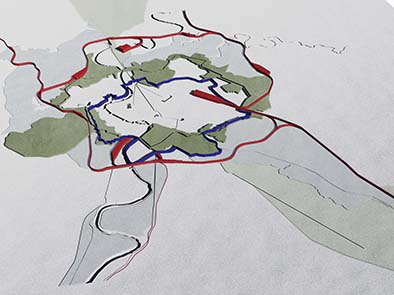A modern city design. Observations on the essay by Marcello Piacentini: On the conservation of the beauty of Rome and on the development of the modern city (1916)
DOI:
https://doi.org/10.6092/2281-4574/7385Abstract
The topic of the article concerns Rome and its modern development, in particular the
years 1930-1960 which enclose a short but very rich season for the Eternal City. Tracing the main events of modern Rome, the article will illustrate the break between the
“historicist vision” of the growth and development of the city(for subsequent organic
additions to the ancient core) and the “modernist vision” for autonomous parts that
produce a city structurally different from the historical one. The recomposition of this
“cultural break” is the basis of the work that architects are called to do in the near future
and the article will try to illustrate the “change of course” necessary to recover urban
quality in the modern-contemporary parts of our cities. The re-reading of Piacentini’s
essay therefore gives us the opportunity to retrace some key passages in the teaching
of urban planning and to reflect on some basic questions. Until the Thirties, the Rome
project was a possible project, for connected but autonomous parts, held together by
the “street” which is the pillar of all public spaces, the connector, the skeleton, the supporting structure of the city body, his “soul” as Piacentini says. Piacentini, in 1931 draws
the eternal city as a whole, in a dimension of otherness with the countryside. The Italian
papers M. Pietrolucci - Un disegno moderno di città. Osservazioni sul saggio di Marcello Piacentini: Sulla conservazione della bellezza di Roma e sullo sviluppo della città moderna
64 Territory of Research on Settlements and Environment - 25 (2/2020) Territory of Research on Settlements and Environment - 25 (2/2020) 65
master of the “conservative” generation, a man of great ability, reflects on the “street”,
on its importance and centrality in modulating the urban space of the city. The distance
from what modernist urban planning was saying in those same years is frightening.
The most esteemed pupil of Piacentini, Luigi Piccinato is, in Rome and in Italy, the interpreter of this “break” that was consummated dramatically on the soil of Rome with
the drafting of the 1962 Plan. It is therefore necessary to resume the ranks of what was
abandoned too quickly by returning to thinking of the city as a set of linked parts that
can be designed as a whole
Downloads

Downloads
Published
Issue
Section
License
Gli autori che pubblicano su questa rivista accettano le seguenti condizioni:- Gli autori mantengono i diritti sulla loro opera e cedono alla rivista il diritto di prima pubblicazione dell'opera, contemporaneamente licenziata sotto una Licenza Creative Commons - Attribuzione che permette ad altri di condividere l'opera indicando la paternità intellettuale e la prima pubblicazione su questa rivista.
- Gli autori possono aderire ad altri accordi di licenza non esclusiva per la distribuzione della versione dell'opera pubblicata (es. depositarla in un archivio istituzionale o pubblicarla in una monografia), a patto di indicare che la prima pubblicazione è avvenuta su questa rivista.
- Gli autori possono diffondere la loro opera online (es. in repository istituzionali o nel loro sito web) prima e durante il processo di submission, poiché può portare a scambi produttivi e aumentare le citazioni dell'opera pubblicata (Vedi The Effect of Open Access).

